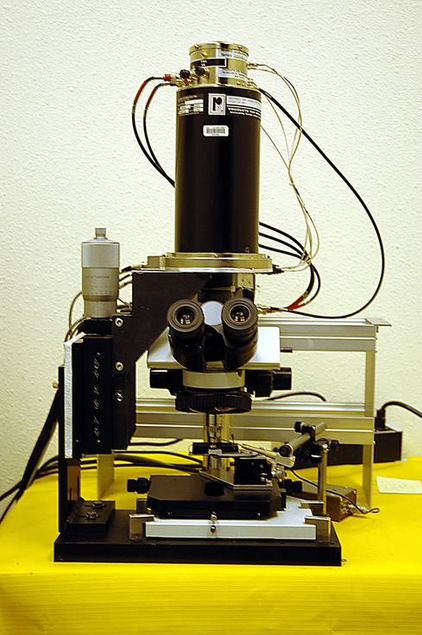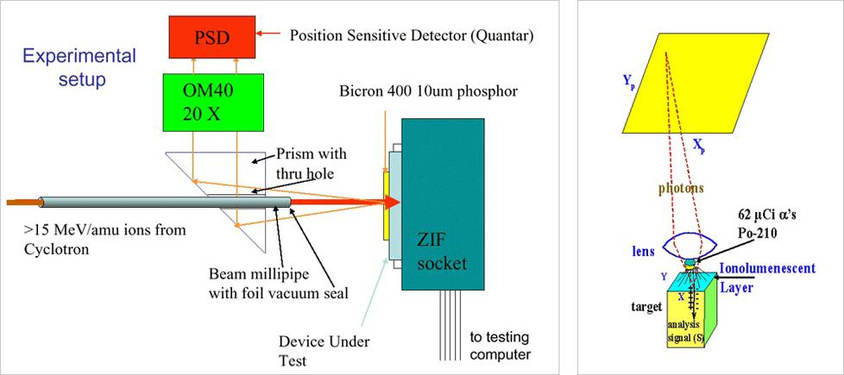The Quantar 2600-IPEM Analyzer

2600-IPEM Series Multi-Dimensional Ion-Photon Nuclear Microprobe System for Induced Ion-Effect Analysis
GENERAL
Semiconductor and microelectronic circuits and devices used in space and other environments are subjected to bombardment by high-energy cosmic ray ions. These interactions frequently result in reliability problems and unpredictable behavior and these effects must be analyzed and characterized to ensure the performance of such circuits and devices. And, as component device sizes continue to shrink, naturally-occurring ion radiation is becoming more of a concern even with devices used terrestrially in commercial applications.
The Quantar 2600-IPEM Analyzers offer a convenient approach to rapidly study and diagno se these type of rad iation-induced problems in IC’s. The system includes a sample mounting stage, a microscope for viewing the area of interest, the MepsicronTM position-sensitive, time-sensitive photon detector system, and a PC-based data collection/display subsystem.
SYSTEM DESIGN AND CONFIGURATION
Historically, laboratory-based, ion-induced radiation effects studies on semiconductors and devices have been performed using spatially-broad beams flooding the sample, generated from a high-energy, lab-based particle accelerator which is a costly and physically large installation. Single-Event-Upset (SEU) crosssections were measured as a function of the ionizing power of the beam. While these approaches have been extremely valuable and productive for overall device characterization, they frequently do not enable the spatial pinpointing of the specific devices within a circuit involved in radiation sensitivity prob lems.
To obtain spatially resolved information, traditional nuclear microprobe techniques require the use of a highly focused ion beam from an accelerator-type source, and such focusing capability further increases cost and complexity, and generally requires operation in a vacuum environment to prevent degradation of the focused beam that would occur in atmospheric conditions.
Focusing the accelerator beam assures only a microscopically sized sample area is illuminated at any one time, thereby enabling the analysis to be isolated to single electronic devices, typically in the range of 1 micron in size. The focused beam is then often sequentially raster-scanned over the area of interest on the sample, creating a point-by-point analysis of the entire device.
IPEM APPROACH USING POSITIONSENSITIVE DETECTION
Using the IPEM (Ion-Photon Emission M icroscopy) approach, the microbeam analysis co nfiguration is essentially reversed.
Instead of requiring the use of a focused beam, the spatially-resolved information is obtained from use of a single-event-counting, position-sensitive detection system. This detector determines the X-Y position of a single ion strike occurring among many in the broad incident ion beam, using a auxiliary photon-generating thin fluorescent film (ion-tophoton converter) located in the plane of the sample.
When this ion-strike spatial location is timecorrelated with a specific observed SEU or charge collection problem event in the device under test, a detailed and quantitative map of radiation sensitivity is produced, which is of much greater interpretive and diagnostic value than are the traditional broad beam tests. An extended sample area can be analyzed and mapped without any point to point scanning, leading to potentially more rapid and comprehensive measurements. No beam scanning or sample displacement system is required and no costly, large and complex accelerator beam focusing equipment is required. In practice, either a broad beam or focused beam ion source (normally limited to the field of view of the optical microscope), can be used with the IPEM approach.
An example of the value of this spatially-resolved failure information is shown below in Figure 1.
Further more, in the IPEM technique, a relatively broad-illumination radioactive MeV-energy source (e.g. 210Po) can be used in place of the accelerator source.
This offers the possibility of a bench-top size analysis instrument, completely independent of the need for an ion accelerator. And, for some applications in biological analysis, such an ion source is preferred. Such an analysis can be conducted entirely in atmospheric pressure environments.
DETAILS OF OPERATION
Mode 1 -Using with an accelerator ion source
This mode is shown schematically in Figure 2.
The ion beam is focused on the target or DUT, normally limited to the field-of-view of the optical detecting microscope (since events occurring outside this region will not be analyzed). The DUT can be in either vacuum or external to the ion-source vacuum (by transmitting source ions through a thin window).
Then, a very thin fluorescent film is placed over the DUT surface. T his film produces one or multiple simultaneous photons in response to the passage of each incident ion from the source. These photons are then projected at high magnification through a conventional optical microscope onto a specialized, X-Y position-sensitive, single-photon-counting, MCP-based photon detector. Because this detector is single-event-counting, the event can be timecorrelated with an upset event that may occur in the device under test (DUT).

Mode 2. Sealed radioactive ion source
In operation, in place of the accelerator ion source, a physically small radioactive source (alpha particle or fission fragment such a 210Po source) is positioned between the objective lens of the optical microscope/detector and the DUT surface.
This mode of operation is shown in schematic form in Figure 3.
Spatial resolution (device spatial identification) is currently limited to approximately 10 microns FWHM.
Between 50,000 and 100,000 detected ion strikes per second can be processed leading to relatively rapid data map development.
PC-BASED DATA SYSTEM
A PC-based multiple-parameter data system captures and displays the X-Y incident ion position information from the position-sensitive detector system and records these positions if coincident upset events are observed in the DUT. Thus, X-Y defect maps, corresponding to the spatial distribution of radiation-sensitive devices in a circuit, are obtained in a single, continuous measurement.

FEATURES
- Enables nuclear microprobe analysis without use of a highly focused, ion-beam accelerator beam
- Can use low-intensity radioactive ion source (not included)
- Analysis can be performed in vacuum or air.
- Can measure carrier mobility μ, carrier lifetime ϒ and calculate mobility-lifetime product
- Integrated, complete system includes sample holder, optical microscope, position-sensitive detector with readout electronics and PC-based data collection/display system, cables and power supplies ...
- Especially suitable for ion-irradiation evaluation of biological systems due to ability to use radioactive alpha sources and operation in atmospheric environments.
ADDITIONAL INFORMATION
Quantar Technology invites inquiries regarding this technology and regarding applications. This information is preliminary and subject to change without notice.
